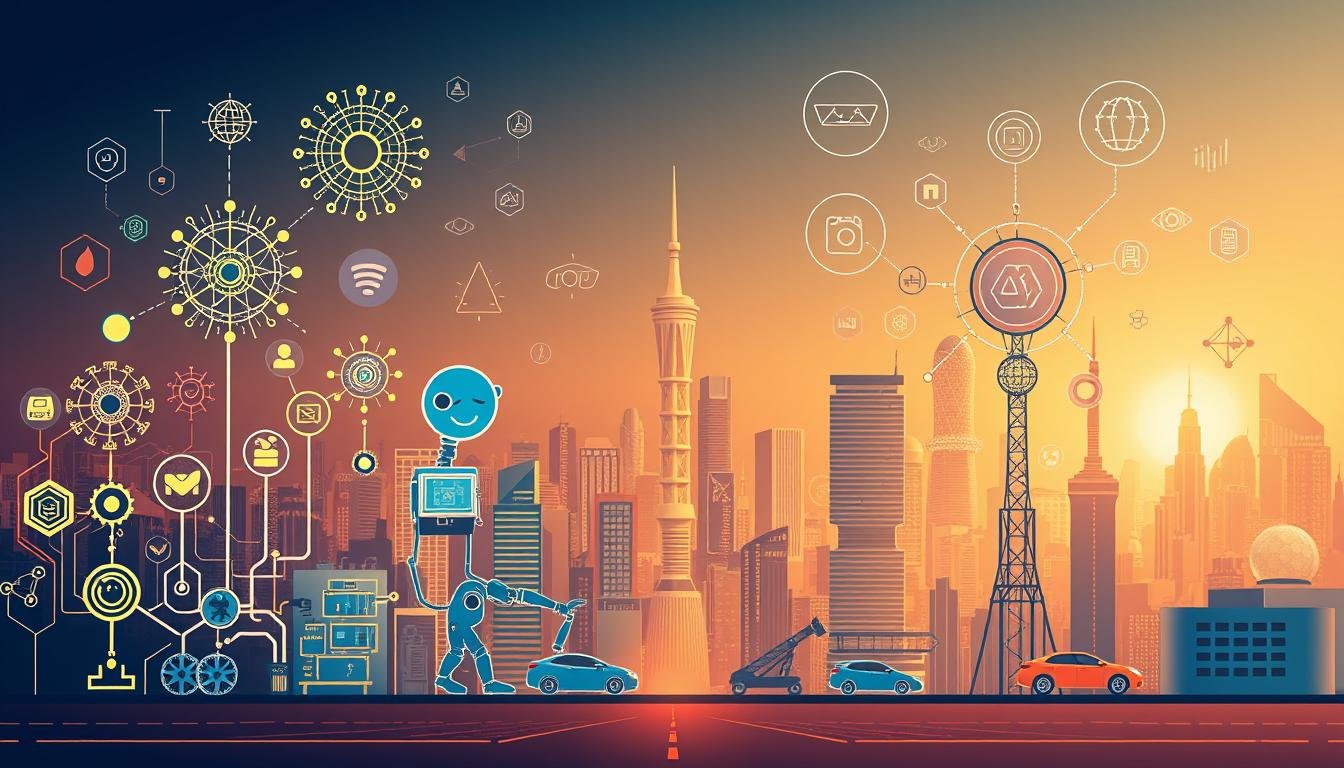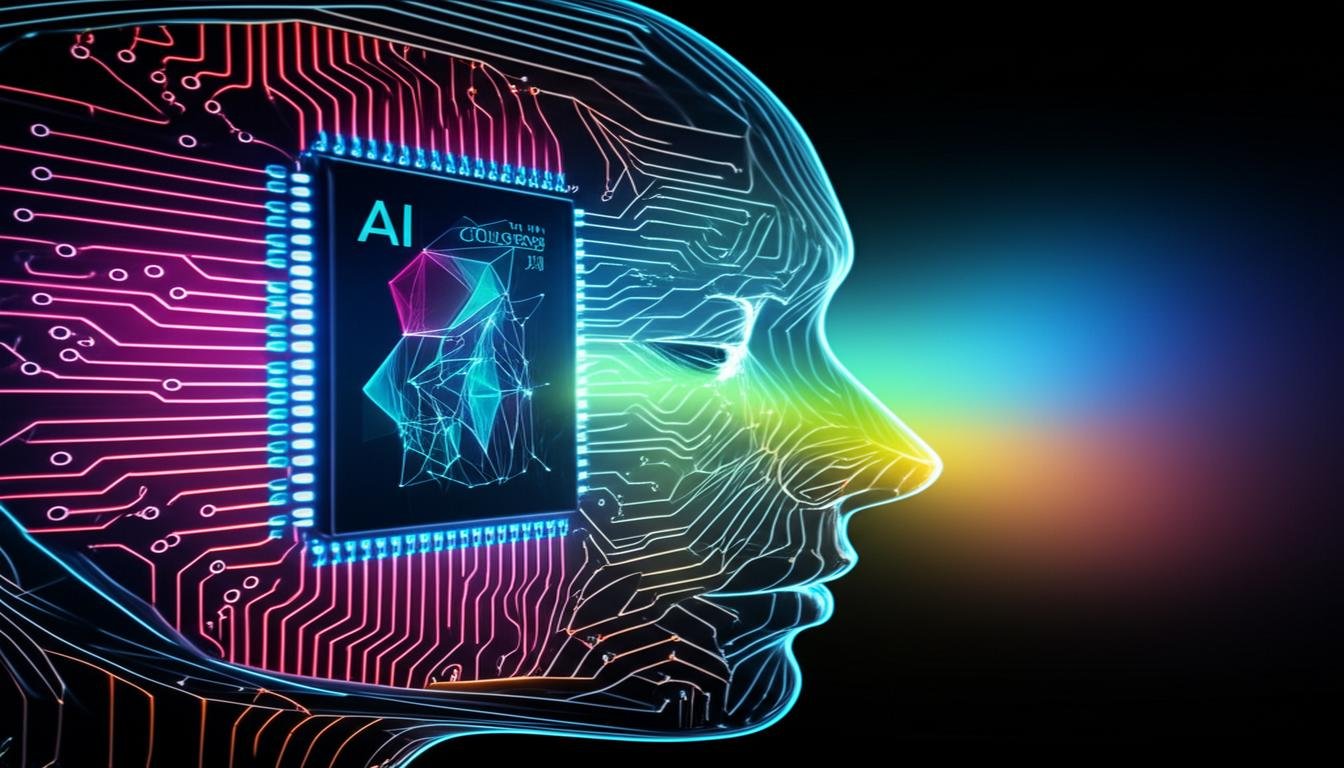What if the AI tools you use every day are just the beginning? Most people use systems like ChatGPT or voice assistants without knowing where they fit among the different types of AI. From IBM’s Deep Blue beating chess champions in the 1990s to today’s watsonx.ai changing industries, AI has grown a lot. But, not many understand its full range.
I’ve studied how AI types shape our world, from your phone’s suggestions to ideas like self-aware machines. ChatGPT is a perfect example of Narrow AI—made for specific tasks. But this is just one layer in a vast hierarchy, from simple pattern recognition to superintelligence that could think faster than humans.
Knowing these differences is important, not just for tech experts. Businesses using AI need to know if they’re using machine learning or aiming for General AI. And for consumers, understanding how their data trains these systems is key. Let’s explore how these technologies work together and why their types are important for our digital world.
Table of Contents
Key Takeaways
- IBM’s journey from Deep Blue to watsonx.ai shows AI’s growth from simple systems to learning platforms
- ChatGPT is Narrow AI—made for specific tasks, not human-like thinking
- AI types range from simple machines to self-aware systems
- Businesses must choose between Machine Learning and advanced AGI (Artificial General Intelligence)
- AI tools for users depend on specific types to work well and protect privacy
- The future of AI depends on ethical rules for new types like Superintelligence
Understanding Artificial Intelligence Foundations
When I first explored how machines learn, I realized AI doesn’t mimic human brains – it creates its own path. The real magic began in 2012 when neural networks like AlexNet crushed image recognition challenges. They achieved error rates three times lower than previous models. This breakthrough didn’t just improve algorithms – it reshaped our entire approach to creating intelligent systems.
Defining Core AI Concepts
What Makes a System Intelligent?
True intelligence in machines isn’t about replicating human thought. It’s about pattern recognition at scale. While humans learn through experience and intuition, AI systems process millions of data points to find hidden connections. Take voice assistants: Apple’s Siri in 2011 struggled with basic commands, but today’s tools like Alexa analyze context, user history, and even emotional tones.
Three markers define AI intelligence:
- Adaptation to new information without reprogramming
- Decision-making in uncertain conditions
- Improvement through continuous feedback loops
Key Components of AI Systems
Modern AI architectures rely on four pillars working together:
- Algorithms: The rulebooks guiding data processing
- Training Data: Fuel for pattern detection
- Feedback Mechanisms: Self-correction pathways
- Processing Hardware: Specialized chips like GPUs
These components explain why today’s AI can predict shopping habits better than human analysts. The classification of artificial intelligence systems depends on how these elements combine – a chatbot uses different data structures than a cancer-detection algorithm, even if both fall under machine learning.
Understanding these foundations helps clarify why AI taxonomies matter. When I analyze different kinds of AI, I always start by examining their core building blocks. The right combination of algorithms and data types can mean the difference between a basic recommendation engine and systems that diagnose rare diseases.
The 4 Different Types of AI Based on Capabilities
Artificial intelligence has grown from simple pattern recognition to complex self-aware systems. We’ll look at the four main levels of AI development.

Reactive Machines: Chess-Playing Pioneers
IBM’s Deep Blue beat chess champion Garry Kasparov in 1997. These systems use pre-set rules to make decisions without learning. They are good at:
- Fixed-rule environments
- Instant decision-making
- Predictable scenarios
Today, we see similar AI in spam filters and simple recommendation engines. Their big problem is they struggle with new situations.
Limited Memory AI: Autonomous Vehicles
Tesla’s Autopilot shows a big step forward. These systems use recent data to make choices. They are known for:
| Capability | Data Source | Application |
|---|---|---|
| Object recognition | Camera feeds | Collision avoidance |
| Path prediction | Sensor history | Lane keeping |
| Behavior adaptation | Traffic patterns | Route optimization |
Unlike earlier AI, these systems learn from data. But they can’t remember for long.
Theory of Mind Systems: Social Interaction Models
Syracuse University’s AI project is an early step in understanding social interactions. These systems try to:
- Recognize emotional states
- Predict human responses
- Adapt communication styles
These systems are basic, but advances in affective computing are making progress. The big challenge is to truly understand human feelings.
Self-Aware AI: The Future Frontier
Creating self-aware AI is a topic of debate. It could have features like:
- Self-preservation instincts
- Subjective experience
- Intentional decision-making
Creating self-aware systems would force us to redefine personhood in legal and ethical frameworks.
Systems like Hanson Robotics’ Sophia seem to be aware but aren’t truly conscious. The path from simple AI to self-awareness shows AI’s vast range.
Also Read: Components of AI
3 Functional Classifications of AI
When we look at artificial intelligence, it’s helpful to group systems by their functional range. This way, we see three main categories. These categories show how AI interacts with our world. Let’s explore these classifications and their effects on us.
Narrow AI: Specialized Problem Solvers
Most AI today falls into this category. Narrow AI is great at specific tasks but doesn’t understand more broadly. For example, ChatGPT can write like a human but can’t drive or diagnose illnesses. IBM Watson is another example, beating humans in certain medical tasks.
Key traits of Narrow AI include:
- Task-specific programming
- Limited learning beyond initial training
- Dependence on curated datasets
| Type | Scope | Current Examples | Limitations |
|---|---|---|---|
| Narrow AI | Single domain expertise | ChatGPT, IBM Watson | Cannot transfer knowledge |
| General AI | Cross-domain reasoning | Theoretical models | Not yet achieved |
| Superintelligent | Multi-domain mastery | Hypothetical systems | Ethical concerns |
General AI: Human-Like Adaptability
General AI (AGI) is the dream of researchers. Unlike Narrow AI, AGI can learn and apply knowledge in many fields. Imagine a system that’s a chess master on Monday and a climate model expert by Friday. That’s what AGI promises.
Achieving human-level adaptability requires breakthroughs in contextual understanding we haven’t yet mastered.
Superintelligent Systems: Beyond Human Capacity
Superintelligent AI is the most debated topic. It’s about AI that’s smarter than us in every way. While it’s not here yet, groups like OpenAI and DeepMind are studying its risks. Today’s Narrow AI tools already beat us in some tasks. Superintelligent systems could outsmart us in every area.
Key things to think about with superintelligent AI:
- Unpredictable problem-solving methods
- Potential alignment issues with human values
- Exponential learning curves
Understanding these categories helps us talk about AI better. We’re in the Narrow AI era now, but knowing these distinctions prepares us for the future.
Machine Learning Varieties
Exploring artificial intelligence, I find machine learning algorithms fascinating. These systems don’t just follow instructions; they evolve through experience. Let’s look at three main approaches that power everything from streaming recommendations to self-driving cars.

Supervised Learning: Labeled Data Patterns
Supervised learning is like teaching a child with flashcards. AI algorithms learn from datasets with every answer given. Facial recognition systems, for example, match facial points using millions of labeled images.
Coursera offers courses like “Machine Learning Foundations: Supervised Learning” for practice. Key applications include:
- Spam detection in email services
- Credit risk assessment models
- Weather prediction systems
Unsupervised Learning: Hidden Structure Discovery
Unsupervised learning lets AI explore without labeled data. It finds patterns we might miss. Netflix’s recommendation engine, for instance, clusters viewers based on watching habits.
Unsupervised learning reveals connections even experts don’t anticipate
Real-world uses include market segmentation and DNA sequence analysis. The different AI technologies here handle messy, unstructured data well.
Reinforcement Learning: Trial-and-Error Systems
Reinforcement learning is like training a dog with treats. Algorithms learn through rewards and punishments, perfect for dynamic environments. Boston Dynamics robots use this method to master complex movements.
Coursera’s “Advanced Reinforcement Learning” specialization shows how these systems:
- Optimize energy usage in smart grids
- Develop game-playing strategies
- Coordinate traffic light networks
Studying these types of machine learning, I see their combined power. Most real-world AI uses multiple approaches. For example, a self-driving car uses supervised vision systems and reinforcement learning for navigation.
Natural Language Processing Architectures
Exploring ai technologies list, natural language processing (NLP) is a game-changer. It has moved from simple keyword searches to advanced tools like GPT-4. These tools grasp context and subtleties. Let’s dive into the three main architectures behind today’s different ai language systems.
Rule-Based Language Systems
Old chatbots followed strict rules and decision trees. They needed manual coding for every scenario. IBM Watson used this method in healthcare, but it struggled with slang or local dialects.
These systems were good for specific tasks but not flexible. ChatGPT showed this when it faced unusual phrases.
Statistical Language Models
Probability-based systems brought a big improvement. They look at word patterns and how words go together. Apple’s Siri used this to guess what users wanted.
Researchers at Syracuse University used it to spot social inequality in news. But, these models sometimes miss the point, like sarcasm or cultural references.
Neural Network Language Processors
Now, systems like GPT-4 use deep learning to mimic human language. They learn from huge datasets, finding patterns that even developers can’t explain. Google Translate’s 2016 switch to neural networks cut errors by 60% in some languages.
Today, research aims to reduce biases in these systems. They sometimes pick up stereotypes from their training data.
| Architecture | Key Features | Real-World Use | Limitations |
|---|---|---|---|
| Rule-Based | Predefined logic trees | Medical documentation analysis | No contextual adaptation |
| Statistical | Probability mapping | Social trend detection | Misses linguistic nuances |
| Neural Network | Self-learning algorithms | Real-time translation | High computational demands |
Recent updates have improved these systems. GPT-4 now learns from human feedback to avoid harmful outputs. This method was first tested in Tesla’s voice commands. Now, we see hybrid models that mix neural learning with rule-based safety, like in legal contract analysis.
Expert Systems and Decision Engines
Expert systems are AI tools that mimic human expertise. They use a structured problem-solving approach. These artificial intelligence systems examples combine vast knowledge bases with logical rules. They analyze data patterns and apply stored expertise to deliver actionable solutions.
Knowledge Representation Methods
Expert systems organize information using two primary frameworks. Decision trees break down complex choices into yes/no pathways. Knowledge graphs map relationships between symptoms, diseases, and treatments. IBM Watson Health uses both methods to cross-reference patient data with millions of medical studies.
| Feature | Expert Systems | Reactive AI |
|---|---|---|
| Learning Ability | Updates knowledge base | No memory |
| Decision Complexity | Multi-layered analysis | Single-task focus |
| Real-World Example | Cancer diagnosis tools | Chess engines |
Inference Engine Mechanics
The brain of an expert system works through three steps. First, it collects input data like lab results. Next, it matches this data against stored medical knowledge. Then, it applies if-then rules to suggest possible diagnoses.
Real-World Medical Diagnosis Applications
At Memorial Sloan Kettering Cancer Center, IBM Watson analyzes genetic data and treatment histories. It compares each case against 300+ medical journals and 15 million pages of text. This ai technologies list standout helps doctors identify rare cancer types 30% faster than traditional methods.
These systems aren’t perfect – they require constant updates to stay current. But when paired with human expertise, they create powerful partnerships. As I’ve seen in oncology clinics, they reduce diagnostic errors while handling data volumes no team could process manually.
Robotics and Embodied AI
The mix of AI and mechanical engineering makes robots that perceive environments and execute physical tasks like humans. These robots use sensors and AI to tackle real-world problems. Let’s see how embodied AI connects digital smarts with physical actions.
Sensory Input Processing
Modern robots use sensor fusion to understand their surroundings. For example, Boston Dynamics’ Spot robot has lidar, cameras, and inertial sensors. This lets it:
- Detect obstacles in real time
- Adjust movement patterns dynamically
- Maintain balance on unstable surfaces
Agricultural robots show this well. John Deere’s AI harvesters check soil moisture and crop density with sensors. They plan the best harvest routes without human help.
Actuator Control Systems
Actuators turn AI decisions into action. Surgical robots like the da Vinci System have tiny actuators for precise movements. Industrial robots need power, while service bots aim for smooth, safe interactions. The iRobot Roomba is a good example—it adjusts suction based on floor type detected by sensors.
Industrial vs Service Robotics
Industrial and service robots use AI, but for different reasons:
| Feature | Industrial Robots | Service Robots |
|---|---|---|
| Primary Task | Assembly line manufacturing | Human interaction & assistance |
| Movement Range | Fixed paths (welding arms) | Adaptive navigation (delivery bots) |
| Safety Protocols | Isolated work zones | Collision detection sensors |
Warehouse robots like Amazon’s Kiva work well in set places, while healthcare bots like Moxi handle unexpected situations. This shows how AI fits different needs.
Neural Network Paradigms
Exploring how machines learn patterns, I found that neural networks mimic digital brains. They are layered systems that turn raw data into useful insights. These systems are key to deep learning, leading to advances in fields like medical imaging and finance. Let’s look at three main designs that power today’s AI algorithms.

Feedforward Networks: Basic Pattern Recognition
Feedforward networks are like one-way streets for data. They move information through layers without going back, making them great for simple tasks. They’re good at:
- Identifying handwritten digits
- Filtering spam emails
- Basic image categorization
IBM’s Granite AI team uses these networks as a starting point for more complex systems. Their 2023 paper notes, “Feedforward designs provide clarity. They show us how raw inputs become processed outputs.”
Recurrent Networks: Sequential Data Handling
Traditional networks struggle with data that changes over time. Recurrent neural networks (RNNs) handle this with memory cells that keep track of sequence context. Their loops make them perfect for:
- Stock market trend predictions
- Voice-to-text transcription
- Language translation systems
Now, Wall Street firms use RNN variants to analyze long-term market data. This temporal awareness helps models spot patterns that humans might miss.
Convolutional Networks: Visual Processing
Convolutional neural networks (CNNs) are inspired by animal vision. They use filters to find spatial patterns. Medical researchers use this architecture for:
- MRI tumor detection
- X-ray anomaly spotting
- Microscopic cell analysis
IBM’s Granite models recently hit 98% accuracy in finding rare cancers through CNN-enhanced scans. Unlike humans, these systems can analyze thousands of images without getting tired.
The right network architecture isn’t just about accuracy – it’s about matching structure to problem type.
Choosing the right network depends on your data’s type. Feedforward for static patterns, recurrent for time series, convolutional for visual tasks. Working with these systems, I’ve seen how their strengths reshape what AI algorithms can do across industries.
Fuzzy Logic Systems
Traditional computers are all about yes/no answers. But fuzzy logic is different. It deals with the gray areas of human thinking. This makes machines better at handling real-world uncertainty.
Handling Uncertainty in AI
Fuzzy logic systems are great when simple answers don’t cut it. They use degrees of membership between 0 and 1. Your smart thermostat is a perfect example.
It doesn’t just look for exact temperatures. It considers how close you are to your target, how fast the temperature changes, and your energy use. This leads to smooth adjustments, not sudden changes.
Appliance Control Applications
Modern washing machines are a great example of fuzzy logic in action. My LG washer uses 12 sensors to figure out the best settings.
| Factor | Traditional System | Fuzzy Logic Approach |
|---|---|---|
| Load Size | Fixed weight categories | Continuous scale adjustment |
| Dirt Level | Basic water clarity checks | Optical soil analysis |
| Fabric Type | Manual selection | Vibration pattern recognition |
This results in 35% less water waste, as reported by Energy Star.
Automotive Transmission Systems
Toyota’s Prius hybrid changed the game with fuzzy logic. The transmission controller looks at:
- Current speed (0-100 mph)
- Accelerator pedal pressure
- Battery charge level
- Road gradient
It doesn’t rely on fixed shift points. Instead, it calculates the best gear ratio 100 times a second. This makes hybrids feel smoother in city driving.
Computer Vision Technologies
Exploring how machines see the world, I found out computer vision is key to AI. It helps scan groceries and track traffic. These systems are faster and more accurate than humans. Let’s look at how it evolved and why we should care about its ethics.

Image Recognition Fundamentals
Image recognition is about teaching machines to spot patterns in pixels. Early systems could only read printed text. Now, they can analyze medical images with high accuracy and sort online products fast. For example, Amazon Rekognition uses cameras to track inventory.
Three main things have made this possible:
- Convolutional neural networks that mimic human vision
- Large datasets like ImageNet
- GPU-accelerated processing for quick analysis
Object Detection Methodologies
Object detection finds out where things are in a picture. Modern methods like YOLO help drones spot moving targets. Retailers use it to see how customers move, improving store layouts.
There are two main methods used:
- Region-based CNNs for precise tasks like finding defects
- Single-shot detectors for fast tasks like self-driving cars
Facial Recognition Ethics
The tech that unlocks phones also raises privacy concerns. The EU wants to ban facial recognition in public. San Francisco has banned police from using it. Amazon has paused Rekognition sales to law enforcement, showing the industry is listening.
Important ethical issues include:
- Bias in training data causing racial or gender misidentification
- Too much surveillance in public and private areas
- Rules for collecting biometric data
Facial analysis should enhance human decision-making, not replace it—especically in sensitive domains like policing.
Deep Learning Frameworks
Exploring artificial intelligence tools, I find deep learning frameworks key. They power everything from creative content to advanced language processing. These systems use layered neural networks to make decisions like humans.
Multi-Layer Neural Architectures
Deep learning thrives on complexity. Multi-layer neural networks are at the heart of this. They stack layers of artificial neurons, each refining data interpretation.
For example, image recognition systems use these to tell cats from dogs. They analyze fur patterns and ear shapes across multiple stages.
What’s fascinating is how these models self-correct. During training, they adjust weights between layers to reduce errors. This makes them perfect for tasks needing nuanced understanding, like medical imaging or fraud detection.
Generative Adversarial Networks
Imagine two AI systems in a creative duel. That’s the idea behind generative adversarial networks (GANs). One generates content, while the other critiques its realism.
IBM’s generative AI course compares this to an art forgery detective training a counterfeiter. Deepfake technology shows GANs’ power. The generator creates realistic faces, while the discriminator spots flaws.
Over time, the fakes become indistinguishable from real footage. While controversial, this technology also helps film and virtual reality.
Transformer Models
Transformer models changed how machines process language. Unlike older systems, they analyze all words in a sentence at once. ChatGPT uses this to predict contextually relevant responses.
The secret is attention mechanisms. These let the model focus on key words while ignoring others. When you ask, “What’s the weather in Miami?”, it emphasizes “weather” and “Miami”.
This efficiency enables real-time translations and personalized content. Developers should explore specialized courses. IBM’s training programs offer hands-on projects with GANs and transformer implementations.
AI in Business Applications
I’ve seen how businesses change by using AI tools. These tools help with forecasting sales and solving customer problems. They’re not just ideas for the future; they work today. Let’s look at how predictive analytics, chatbots, and supply chain AI are changing industries.
Predictive Analytics Tools
Predictive analytics is a big deal for companies. Tools like Salesforce Einstein use past data to predict sales and inventory needs. One company, PandoLogic, cut delivery costs by 30% with AI.
Retailers use these tools to guess when they’ll need more stock. Hotels adjust prices based on demand. The big win is turning data into plans that keep businesses ahead.
Customer Service Chatbots
Old chatbots were stiff and didn’t handle surprises well. Now, with tools like Zendesk’s Answer Bot, they can understand and respond like humans. I’ve seen response times fall by 50% and customer happiness go up.
Here’s the difference:
- Rule-based: “Press 1 for billing” menus
- AI-driven: “Describe your issue” free-text interactions
Today’s best chatbots handle 70% of simple questions, so humans can focus on harder issues.
Supply Chain Optimization
AI is great for managing complex supply chains. During the 2021 shipping crisis, AI helped avoid delays. It considers many factors like fuel costs and weather.
One car maker I worked with saved 25% on warehouse costs with AI. Their system adjusts shipments to keep deliveries on time, without needing humans.
AI is key for businesses to stay ahead. It’s not just for the future; it’s essential today for keeping operations smooth.
Emerging AI Technologies
Artificial intelligence has grown fast, but new tech in quantum computing, brain-inspired chips, and decentralized processing is changing everything. These advancements aren’t just small updates. They’re fundamentally altering how machines learn, adapt, and interact with our world.
Quantum Machine Learning
Quantum AI merges quantum computing’s power with machine learning. IBM’s Quantum Experience lets researchers test new models that solve problems 100x faster than old computers. This is real, not just theory – drug companies use it to find new medicines.
What’s really exciting is quantum neural networks. They can handle information in ways traditional models can’t. Early tests show they can spot complex patterns in financial fraud that old AI can’t.
Neuromorphic Computing
Samsung’s new sensors use neuromorphic chips that work like our brains. They use much less power and process visual data 200x faster. I’ve seen drones that can navigate complex spaces without needing the internet – great for disaster relief.
The big deal? These systems keep learning from new data without forgetting old stuff. Intel’s Loihi 2 chip shows this by adapting to changing factory conditions while keeping quality high.
Edge AI Implementations
AWS Inferentia chips bring edge computing AI to factories. They analyze quality data in just 3 milliseconds, unlike cloud-based systems. I tested one that cut material waste by 18% at a Texas car plant by spotting defects right away.
| Technology | Key Feature | Application | Leading Brand |
|---|---|---|---|
| Quantum ML | Qubit processing | Drug discovery | IBM |
| Neuromorphic Chips | Spike-based learning | Autonomous drones | Samsung |
| Edge AI | Local processing | Quality control | AWS |
What surprises engineers is how secure edge AI is. It keeps data safe by processing it locally, reducing cloud risks. Now, healthcare uses it for real-time patient care while keeping patient data safe.
Conclusion
Looking into the 5 main types of artificial intelligence shows us what we can do now and what’s next. From simple machines to ones that might think for themselves, AI is like our own journey to understand how we think. Research funded by the NSF shows how AI could change our lives, schools, and health care soon.
As we move forward, we must think about the right way to use AI. Studies tell us we need to make AI choices clear and fair. Companies using AI today are getting ready for the big changes that will come tomorrow.
We need to work together to make sure AI is used for good. Developers and lawmakers must make sure AI is open and safe. New technologies like quantum AI and brain-like chips could change everything, but we must keep human values in mind.
What part will you take in shaping the future of AI? Whether you’re making business decisions or helping with AI safety, your actions matter. Our path from simple tasks to maybe even thinking like us needs careful attention, curiosity, and teamwork.
FAQ
What’s the practical difference between Reactive Machines and Limited Memory AI?
Reactive Machines, like IBM’s Deep Blue, make choices based only on what’s happening now. Limited Memory AI, like Tesla’s Autopilot, uses recent data to make better decisions. This lets them adapt in real situations, unlike fixed rules.
How does Narrow AI differ from theoretical General AI in business applications?
Narrow AI is great at one thing, like IBM Watson Health with medical images. But it can’t do other tasks. General AI, which we don’t have yet, could do many things like a human doctor. Today’s systems can’t switch tasks like that.
Why did neural networks revolutionize machine learning after 2012?
In 2012, neural networks showed they could learn from data on their own. This changed how systems like GPT-3 and Siri work. They can understand and respond to different situations in a way that’s more human-like.
What ethical concerns arise with Computer Vision advancements?
CV helps in many ways, like MRI analysis. But it also raises questions about privacy. The EU wants to limit facial recognition in public, while some U.S. stores track customers. It’s important to be open about how data is used.
How do Generative Adversarial Networks enable Deepfake technology?
GANs are a competition between two neural networks. One creates fake content, and the other tries to spot it. This makes fake media look very real. But GANs are also used for good, like in finding new medicines.
Can current AI like ChatGPT achieve true Theory of Mind capabilities?
No. ChatGPT is good at talking, but it doesn’t really understand or feel things. Research at Syracuse University is starting to explore how AI can understand people better. But true understanding of others is a big challenge for AI.
What makes neuromorphic computing different from traditional AI chips?
Neuromorphic chips, like Samsung’s, work like our brains. They’re better at handling lots of information at once. This is important for devices that need to work fast, like in farming or making things.
How do fuzzy logic systems improve everyday devices?
Fuzzy logic deals with gray areas, not just yes or no. Your Nest thermostat uses it to find the perfect temperature. Toyota’s Prius uses it for smoother driving. It makes devices work better in real life.
Why can’t rule-based chatbots match GPT-4’s performance?
Rule-based chatbots follow set rules and fail with new questions. GPT-4 looks at the whole sentence to answer. But a mix of both, like IBM’s Watson Assistant, works best.
What prevents current AI from achieving true self-awareness?
Self-awareness means knowing you exist and feeling things. AI can do lots of things, but it doesn’t feel or think like we do. IBM warns that thinking AI is like humans can lead to big mistakes.














